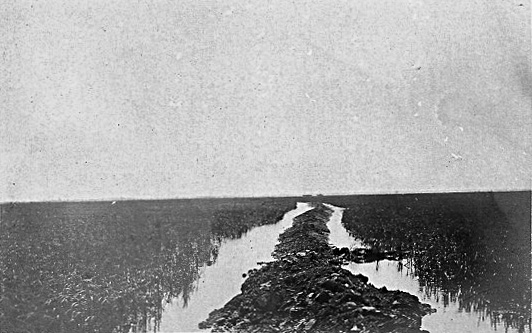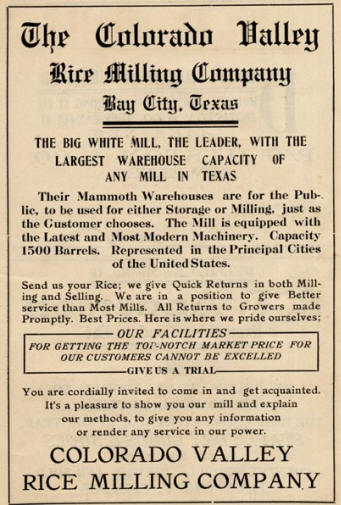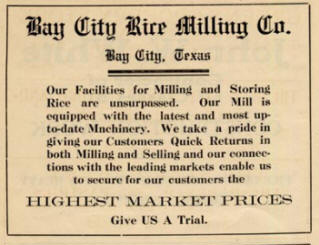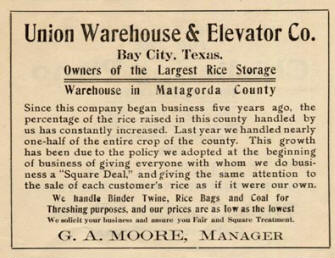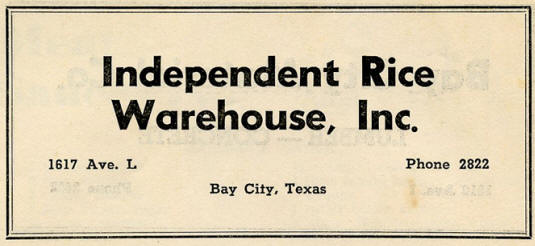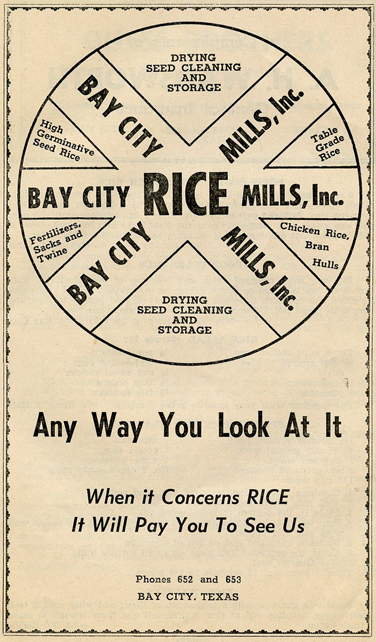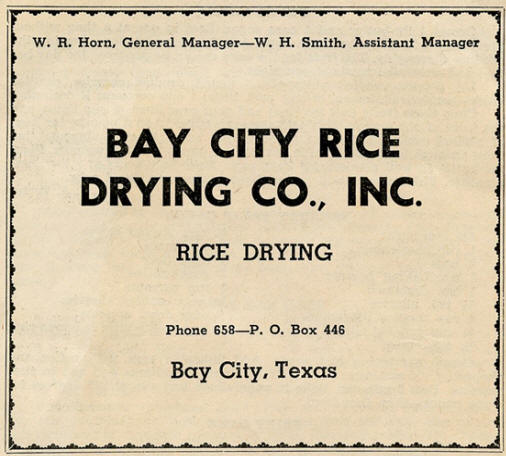|
|||||
|
The Rice Industry of Matagorda County saw its beginnings with A. P. Borden of Pierce, TX breaking out the first land for rice cultivation about 3 miles north of Bay City in November of 1899. The next month, the Matagorda Rice and Irrigation Company began preparations to plant rice the coming year. The success of this first years‘ planting of 600 acres of rice in 1900 enticed others to plant rice the next season. One story tells of Franz Huebner, while on a cattle drive, discovering rice being grown near Eagle Lake on lands of Captain William Dunovant. Huebner and his associate, Henry Rugeley, then traveled around the state and into Louisiana to learn more about rice cultivation, and its potential to be grown profitably in Matagorda County. They brought a Louisiana rice farmer back with them to explain the process to Matagorda County farmers who, then, developed the rice culture here. The next decade was a period of great development and change in the county. The expanding potential for rice production required improved transportation; The Cane Belt Railroad came to Bay City on June 30, 1901, providing the first of several rail lines to serve Matagorda County. Colonization of the entire Gulf Coastal area of Texas was promoted during this period, and the railroad made this migration possible. Settlers were brought in on railroad excursions from the mid-west and other areas, and many were enticed to settle in Matagorda County. The fledgling Rice Industry provided the spark to develop the coastal plains that had primarily been grazing lands up to that point in time. The Matagorda County Rice Mill was organized and built in 1902 adjacent to the Cane Belt right-of-way. Rice production required irrigation, and the Colorado River provided this resource. Over the next ten years or so, about a dozen irrigation companies organized and built canal systems and pumping plants to bring this economic life-blood of the rice industry to the individual farms. In about 1926, all of the independent irrigation companies were consolidated into the Gulf Coast Irrigation Company through the involvement of V. L. LeTulle. Successful rice production required ample water supplies, which were dependent on upstream rainfall. Historically, there had been periods of ample run of river water, as well as periods of drought, which limited the amount of acreage that could be irrigated. Since the infancy of the rice industry here, conservation of the waters of the Colorado has been a crucial issue. As early as 1911, the Dallas Morning News reported that Matagorda County rice farmers supported a plan to conserve excess river flows in reservoirs for use in times of drought. In 1915, a group of Matagorda County citizens was instrumental in organizing the Colorado River Improvement Association, which included the lower counties, and first met at Bastrop to address issues vital to the lower basin. The continued efforts of Matagorda, Wharton and Colorado County citizens were instrumental to the creation of the Lower Colorado River Authority (LCRA) in 1934. The LCRA was supported by lower counties in the basin for flood control and conservation, and, by finally storing the excess flows of the river, the periodic, damaging floods that had plagued the counties had been minimized, and a more reliable source of irrigation water was secured. From the LCRA website: According to state water law, first in time is first in right. It was determined that rice farmers had some of the earliest water rights in the Colorado basin, and these rights are senior to LCRA's water rights for the Highland Lakes. In fact, without the support of the rice farmers, the Highland Lakes and dams might never have been built. Rice farmers were among the strongest supporters of building the Highland Lakes and dams in the 1930’s. Throughout the history of rice production in Matagorda County, the acreage ranged from the 600 acres in 1900 to a high of 55,000 acres in 1979. In the early 1980’s, semi-dwarf varieties were introduced that were of shorter stature and were resistant to lodging, and had higher yield potential. Matagorda County rice farmers actively co-operated with Extension Service specialists in all aspects of rice production in an effort to maximize production and minimize chemical inputs and costs in various areas of research. The resulting findings produced specific recommendations for achieving the desired goals of production efficiency and yield enhancement that are referred to as “Best Management Practices.” These practices did result in increased yields while controlling costs, improving water quality, and benefitting the environment. More recently, new varieties have been introduced that can produce more than 12,000 pounds per acre, while reducing water usage. Texas rice producers are the most productive in the world. In crop year 2011, Matagorda County farmers reported 21,479 acres of rice planted, but due to the extreme drought of that year, an Emergency Order by the Texas Commission of Environmental Quality was issued that required a total cut-off of releases for rice irrigation from the Highland Lakes, thereby limiting rice production in the county to 1561.9 acres in 2012. These acres were farmed by those who irrigated from wells or who had other surface water rights. There were 19,390.7 acres reported as prevented planting acres.
2012 is the
first season in 112 years that water from the Colorado River has not
been available to grow rice in Matagorda County. |
|||||
|
The rice industry and Matagorda County began in 1900, with an experimental crop financed by a few local citizens. This crop was immensely successful, and from that time forward the rice farming and processing industry expanded rapidly. Many miles of your engaging canals were constructed, huge pumping plants were installed on the Colorado River; and thousands of acres from year-to-year succeeded the original experimental patch of 1900. The first man to break ground for planting rice and Matagorda County was A. P. Borden of Pierce, who began working his plows three miles from Bay City in November, 1899. The Matagorda County Rice & Irrigation Company began work the following month. The acreage of both aggregated 600 acres in 1900. In the 1901 Rice Carnival issue of the Matagorda County Tribune, the editors stated there were profits to be made in rice: The yield was ten to twenty sacks per acre, owing to the fertility of the land and the quality of seed. The market price was $3.00 to $3.50 per sack for the best grades and with proper selection of seeds and proper care of the grains there is no need of having low grades. The gross return was $30.00 per acre or $3000 for 100 acres. After paying for this seed and extra help in harvesting each 100 acres the crop gave a net return of $2,500 or $25 per acre. This was ten per cent on a value of $250 per acre. Land that makes such returns cannot long be bought for $10 to $15 per acre. George H. East of Beaumont sold $9,735 worth of rice from 216 acres; Captain William Dunovant of Houston sold $14,000 worth from 300 acres; and A. P. Borden of Pierce sold $2,500 from 100 acres lying within three miles of Bay City. Thus was the success story of the first rice crops in this area. The story is told that rice, one of the largest industries and Matagorda County, was discovered by a man on a cattle drive. In 1900 for Franz Huebner discovered rice growing on the land of Captain William Dunovant near Eagle Lake and reasoned that the same thing could be done and Matagorda County. Huebner and an associate, Henry Rugeley, decided to travel around the state and to Louisiana to determine whether or not rice could be a profitable local crop. When they returned they brought with them a Louisiana rice farmer, who could explain the process to local farmers, so they could duplicate his method. From this small 600 acres in 1900, the rice acreage increased to 55,000 acres in 1973. With the coming of rice, the system of canals and rice milling, which developed within the county, boosted the economy at the turn-of-the-century. The Matagorda County Tribune, of July, 1901, tells of a $50,000 rice mill to be built in 1902: Within the last week the company has been organized with $50,000 capital to build a rice mill and warehouse here and a charter has been applied for. The prime movers are I. Marks, of Crowley, Louisiana; W. T. Goode of Olathe, Kansas, and Henry Rugeley of Bay City. They have bought a blocked abutting on the Cane Belt sidetracks, and they now have carpenters figuring on a warehouse 64 x 208 feet, the front to be two stories high, with offices, sample rooms, farmers waiting room, etc. upstairs. It will have double floors and in all respects will be first class. At this warehouse Rice will be stored in insured for the grower till he can sell to advantage, receiving a certificate upon which he can borrow money if he wishes to do so. At the farmers waiting room a full supply of all kinds of literature bearing on the rice business in all its branches will be kept on hand for farmers to freely examine my eating their lunch. Daily market quotations, both by mail and by wire, will be received and bulletins for the benefit of the growers; and from time to time the rice dealers everywhere will be informed of the number of sacks of rice stored and for sale. This will bring competing buyers from everywhere, and will enable the growers to get the best price to be had. Next year the company will erect a first-class rice mill and probably an ice factory and a electric light plant. Mr. Marks has had several years of experience in the rice milling business in Crowley, Louisiana. He has also been in the banking business there, and Mr. Goode has been banking and Kansas, while Mr. Rugeley is the well-known cashier of the Bay City Bank. All are thorough-going businessmen and have ample capital, and we have found them exceedingly suave, agreeable gentleman. They expect to have their warehouse finished by the 15th or 20th of August, and will tender it to the use of the public at the big barbecue, both day and night. On August 21, 1901, the first Rice Carnival in Matagorda County was held in Bay City to celebrate not only the successful rice crop but also the coming of the Cane Belt Railroad into Bay City. Part of the celebration was held in the rice warehouse being built at that time by I. Marks. The Matagorda County Tribune, October 11, 1901, after the successful “Rice Carnival” on August 27, 1901, wrote: Scarcely three years have passed since the first grain of rice was sown on the prairies west of Houston. In the spring of 1899 Captain William Dunovant planted the initial crop of 300 acres at Eagle Lake in Colorado County, Texas, the product of which was sold for $14,000, after reserving a large proportion for seed. From that beginning the industry has spread like magic, particularly along the Colorado river. Four counties now represent the new region of the Colorado Valley and luxury crops of rice, approximating between forty and fifty thousand acres, are at present growing in Austin, Colorado, Wharton, and Matagorda counties on prairie land, which until recently was thought to be useless except for grazing cattle. While the prairies, newly found to be susceptible of development in rice culture, are coming into requisition, steps are also being taken to utilize the rich alluvial lands for sugarcane growing, which industry, except for comparatively small enterprises, like in the prairie grasses, has slept in the heavily timbered lands along the Colorado river. When the twin sister, rice, lifted its head in this favored agricultural region, home capital saw its opportunity and a few brave spirits got together and commenced the building of a railroad from Sealy, the capital of Austin county, to Bay City, the capital of Matagorda county, which railroad was completed the past summer, penetrating the heart of the country which will make it one of the most valuable roads for its length in the United States. This railroad is called the “Cane Belt” and it was to celebrate the completion of the Cane Belt Railroad to Bay City that moved the enterprising people of Matagorda County to act with a common impulse and provide an entertainment which will go down in history among the great achievements for hospitality, sociability and business sagacity. The Rice Carnival was the crowning event of two years industrial awakening in the Colorado Valley. Invitations had been extended far and near, and on the appointed day, the embryo city at the terminus of the Cane Belt railroad, with a total population of less than 1000 people opened her gates to more than 5000 people. Bay City was in gala attire for the occasion…Six long tables more than a block in length with snow white cloths were located in the shadow of the rice warehouse, partially finished, on the railroad tracks near the town. Thirty head of cattle, twenty sheep and a dozen hogs have been barbecued in a manner to suit epicurean. Other good things to even drink were lavished and abundant upon the guests as they poured into the little city by the thousands on the several trains during the morning and the afternoon of August 28, 1901, a red letter day in Texas coast county development. Nothing occurred to mar the perfect enjoyment of the occasion. A spirit of abandoned took possession. Conventionality was thrown to the winds. Music from several bands filled the air. Speeches by orators and statesmen in the afternoon entertained the throng, and Terpsichore held sway throughout the night in the long, commodious hall of the new warehouse. The railroad service for newly equipped road with admirable. Trains left at the convenience of the guests, as they had brought the great crowd together during the day, and the universal comment was that the Cane Belt officials “acted like veterans at the helm.” From Wharton the Cane Belt runs through a skirt of timber which will one of these days been planted in sugarcane. Eight miles out from Wharton began Bay prairie, an almost level body of beautiful rice land, varying in width from five to eight miles between the Colorado river on the right, and the Caney river on the left, stretching away for nearly 50 miles to Matagorda bay. Twenty miles from the gulf is the site of Bay City, almost midway between the two rivers, and taking its name from Bay prairie, of which it is approximately the center. Along the railroad for fifteen miles above Bay City is almost a succession of rice plantations, on land which until this year [1901] never before had the sod broken for agricultural purposes. They represent a total of 20,000 acres now growing in rice, and prospects are that this acreage will be more than trebled the next year. The rice was looking well in instances where irrigation had been perfected, and every planter seemed to be eminently well satisfied with the result of the first years’ experience. Bay City is but little over six years old; as a brick court house, costing $31,000, and a brick county jail, $10,000, besides good schools and several churches. With this certain development of the area of rice lands surrounding, Bay City will rapidly grow into a town of much importance. Prominent among those who made the rice carnival a success were: Messrs. C. P. Moore, G. M. Magill, Editor J. L. Ladd, Wm. E. Austin, Hy Rugeley, I. Marks, V. L. LeTulle, Jonathan Lane, William Dunovant, W. T. Eldridge and Charles Boedeker, of the Cane Belt Railroad Co. [Matagorda County Tribune, October 11, 1901] The rice industry in Matagorda County continued to prosper and by 1917 was one of the principal rice milling centers in Texas. Bay City's two mills cleaned approximately 200,000 bags of rough rice in 1916. The value of this product-in-the-rough was estimated at$602,957.15. The mills in Bay City employed some 65 persons in 1916. The payrolls distributed to these employees totaled $25,000. The approximate capitalization of the mills amounted to $150,000 There were eleven large irrigating plants in 1916 capable of irrigating 286,000 acres of land. There were 235 miles. 60,000 acres were under irrigation. These eleven canal systems were: (1) Collegeport Rice and Irrigation Company-- length of canal system sixteen miles with twice that many laterals and capable of watering between 25,000 and 30,000 acres. (2) Consolidated Canal Company-- no pumping plant; it wants its water from the Lane City Canal Company; length of canals and laterals 28 miles land adjacent to canal which can be irrigated 14,000 acres. This plant began operation in 1915 (3) Markham Irrigation Company-- maximum number of acres watered in any one year, 12,000, and adjacent and susceptible to water 60,000 acres; length of canal 42 miles. (4) Northern Irrigation Company-- maximum number of acres watered in any one year 12,000 acres; length of canal 30 miles; land adjacent to and susceptible to water 40,000 acres. (5) Matagorda Canal Company-- maximum number of acres watered in any one year, 7000; length of canal and laterals 30 miles, land adjacent to canal and susceptible to water, 20,000 acres. (6) Texas Irrigation Company-- maximum number of acres watered in any one year 7,000; length of canal and laterals, 30 miles; land adjacent to canal and susceptible to water, 20,000 acres. (7) Texas Irrigation Company-- maximum number of acres watered in any one year 8,800; length of canals and laterals 30 miles; land adjacent to canal and susceptible to water, 30,000 acres. (8) Stuart Canal Company-- maximum number of acres watered in any one year, 2,500; length of canal 8 miles, land adjacent to canal and susceptible to water, 6,000 acres. (9) Security Canal Company-- maximum number of acres watered in any one year, 6,000; length of canal, 22 miles; land adjacent to canal and susceptible to water, 12,000 acres. (10) Gravity Canal Company-- maximum number of acres watered in any one year 10,000; length of canal, 40 miles; land adjacent to canal and susceptible to water 30,000 acres. (11) Colorado Canal Company--maximum number of acres watered in any one year, 10,000; length of canal 35 miles; land adjacent to canal and susceptible to water, 30,000 acres. (12) Buckeye Canal Company-- maximum number of acres watered in any one year 5,000; length of canal and laterals, 10 miles; land adjacent to canal and susceptible to water, 14,000 acres. The possibilities for rice development over the next decade was unlimited, and from the mule drawn equipment of the early 1900s into a more mechanized farming, Rice continued to be the number one crop in Matagorda County. In 1929 a total of 7,452 acres of rice was harvested; 1939-16,116; 1949-58,550; 1964-44,990; 1969-36,138; 1970-46,400; 1973-55,500.
Historic Matagorda County, Volume I, pages
218-224, 1986 |
|||||
|
The editors remained in Beaumont until late in the evening, returning to Houston about midnight. After a good night’s rest a special train was boarded for Markham and Bay City which was to complete the “Industrial Texas” jaunt. The route traversed was via Rosenberg and then over the Macaroni line to Wharton. When a few miles out of Houston, J. L. Ladd of the Bay City Tribune, who had been with the escorting party on the entire jaunt, passed through the coaches and distributed printed slips bearing the following useful and serviceable information: 1. A few miles out of Houston we cross the Brazos Valley, with immense cane fields and sugar mills on either side of the track. 2. From Wharton to Van Vleck we traverse the famous Old Caney Valley for thirty miles, noted as probably the richest bottom lands in the world, having produced 125 bushels of corn per acre on 150 acres, and four bales of cotton per acre on sixteen acres. 3. From Van Vleck, six miles east of Bay City, to Markham, a new town six miles west of Bay City, we pass through ride fields and see steam plows, preparing the seed beds, steam preparing the seed beds, steam grading machines throwing up the canal levees, and the young rice in various stages of growth. 4. Passing through Bay City, with its immense rice mills, and huge warehouses literally covering acres of ground, we pause on the west side of the Colorado River where the fine pumping machinery of the Northwestern Irrigation Company is in process of construction, nearing completion. 5. At this point we become the guest of the Moore-Cortes Canal Company and take a wagon ride to their large pumping plant, where we see four pumps in operation, throwing up into the canal 120,000 gallons of water per minute. 6. Returning to the train, we proceed to Markham, in the center of the twenty-thousand acre rice plantation of the Moore-Cortes Canal Company and become the guest of the Markham Townsite Company at a barbecue dinner. 7. Returning to the east side of the river we pause to witness the operation of the pumping plant of the Colorado Canal Company, where a single pump, weighing thirty tons, throws up 70,000 gallons of water per minutes, and twin pumps of the Gravity Canal Company throw up 100,000 gallons a minute. Those pumps are but a few yards from where the train stops. 8. Proceeding to Bay City we go through the two huge rice mills, each having a capacity of fifteen hundred barrels a day and both right on the railroad track. 9. The ladies of Bay City will serve an informal lunch at the Martin Hotel just before the party leaves for Houston, where we will arrive in time for the excursionists to take the night trains for their several homes.” The journey was an enjoyable one to Bay City. A short stop was made on the first entrance, the train continuing three miles beyond the city to the Moore-Cortes canal. At this point the excursionists entered wagons provided by the Moore-Cortes people and were driven to their pumping station, a mile and a half to the north. The process of seeing a dry canal turned into a raging stream was here witnessed. The company has two huge pumps with a capacity of lifting 130,000 gallons of water from the river into the canal. It was intended to return to the train and then go to Markham by rail but some one of a officious nature, who was also doubtless afraid that the editorial gang intended to give Markham the go-by, took it upon himself to send word to the engineer to continue to Markham and the party would make the trip in wagons. The order was obeyed and a five mile ride in wagons with baled hay for seats and over a hog wallow prairie followed. Feelings can be imagined better than described. The hospitality in the affair was appreciated but the ride by train would have been preferable. At Markham the Markham Townsite Company acted as host and served a banquet and barbecue. This place is one of the Aladdin like results of rice cultivation. Six weeks ago it was a bit of bald prairie. Now a freight and passenger depot and fully twenty-five houses are in course of construction. It is intended to erect two rice mills within a year and it was prophesied that the population of Markham will reach 2000. The party was then taken back to Bay City. They were then escorted to the Bay City rice mill, one of the largest in the country, where the milling process was thoroughly explained. After this inspection they repaired to a hotel where the ladies had prepared a sumptuous banquet. It was a rice banquet with a few accessories. There was rice in every shape and form imaginable and it opened the eyes of the average country editor who had been accustomed to taking his rice plain boiled or served in puddings, to see the different savory dishes that could be prepared from the grain. The town of Bay city is eight years old. In reality it dates its birth back at three years as before that time the town consisted of a courthouse and a few residences. Now it has nearly 3000 population, fine school buildings, many business bricks, and is steadily building. Matagorda county is pre-eminently adapted to the cultivation of rice. The soil, climatic conditions and facilities for irrigation surpass even the favored and proven rice sections of Louisiana. There are at present over 60,000 acres of rice in cultivation and indications are that this acreage will be doubled the coming year. Northern capital is deeply interested in rice and is rapidly developing the country. The Northern Company figures on putting in 17,000 acres next year. There are two rice mills in Bay City and Markham expects two before the year is past. If this is not sufficient to handle the crop there is ample capital to erect more. The most remarkable feature of the Matagorda country development is that a few years back it was considered good for nothing but grazing. The discovery of its adaptability to rice cultivation is really due to the untiring efforts of Colonel S. F. B. Morse of the Southern Pacific who has done more than any one man in Texas to develop our latent resources. The following large irrigation and rice companies are now operating in Matagorda county, together with their acreage: Moore-Cortes Irrigation Company will cultivate this year 12,000 acres, next year 16,000 Northern Irrigation Company, this year 7,000, next year 17,000 Buckeye Irrigation Company, this year 5000, next year 15,000 Tres Palacios Irrigation Company, this year 5000, next year 15,000 Matagorda Rice and Irrigation Company, this year 7000 Colorado Canal Company, this year 7000, next year 14,000 Sexton Irrigation Company, this year 7500, next year 14,000 Stuart Canal Company, this year 5000, next year 12,000 It had been the intentions of the party to remain in Bay City about three hours but owing to unforeseen matters the stop had to be curtailed which was regretted by both entertainers and the entertained. The ladies, when the special was ready to leave packed two large hampers of eatables from the banquet which served as supper while en route to Houston. On readying the Bayou City the jaunt was ended and the members, with the exception of a small party which went to Galveston, left for their respective homes. The convention of 1903 will always be a red letter one in the history of the Association and will undoubtedly serve as a criterion by which future meetings and journeys will be judged. President Clarence Ousley has set a pace that will make his successors in office get up and hustle to duplicate. The affairs will be in the hands of a worthy successor however, Bob Yantis of Athens, the present presiding executive being a stem winder with a double barreled ability for work. When the association convenes in San Antonio in 1904 Yantis can be expected to have looked after the boys’ welfare and pleasure. Hallettsville Herald, July 2, 1903 |
|||||
|
Nearly Ten Thousand Acres of the Robbins Ranch Sold to Grow Rice. Fred S. Robbins was up from his elegant ranch home Tuesday, closing up the sale of some 6,500 acres of his land, including the ranch home, and 1,300 acres of his mother’s land and 1,737 acres of his brother Sam’s land, all forming one body of 9637acres fronting on the west bank of the Colorado river, about a mile or two from the town of Matagorda. This is an exceedingly fine body of land, has a very light water-lift, a magnificent pumping site and it can be reached by boats to convey the product to the terminus of the Cane Belt railroad on the bank of the bayou at Matagorda, or to Galveston or any other coast port. Altogether it is probably the most attractive irrigation proposition in the rice belt today. This land sold for $17.50 an acre and the deal was negotiated jointly by R. L. Armstrong, G. M. Magill and Wm. E. Austin & Co., and the purchasers are a Chicago syndicate who expect to begin developing it at once, though they do not intend to repeat the mistake that has so often been made on this river, of getting tenants upon the land and have them expend their time and labor in preparing for a rice crop while the canal is being constructed and the pumping plant erected. They will not attempt to put in any rice next year. Another thing we like about their plans is that they propose to cut this land up into small tracts and sell it to northern farmers that they will bring down at the proper time. Mr. Robbins still owns about 500 acres, being the upper and northern portion of his ranch, so that it will not be necessary for him to sell his herd of registered Devon cattle. Whether he will now build on this land or move to some nice town to live, we are not informed, but we should be pleased to see him and his most charming wife come to Bay City to live. They are among the best people we have ever known, and the most useful. Matagorda County Tribune, December 4, 1903 |
|||||
|
|
|||||
 Typical Early Rice Canal in Matagorda County - 100 ft. wide, 6 ' deep |
|||||
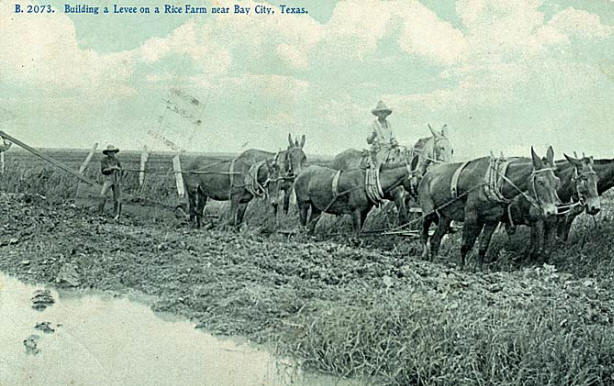 Building a Levee on a Rice Farm near Bay City, Texas |
|||||
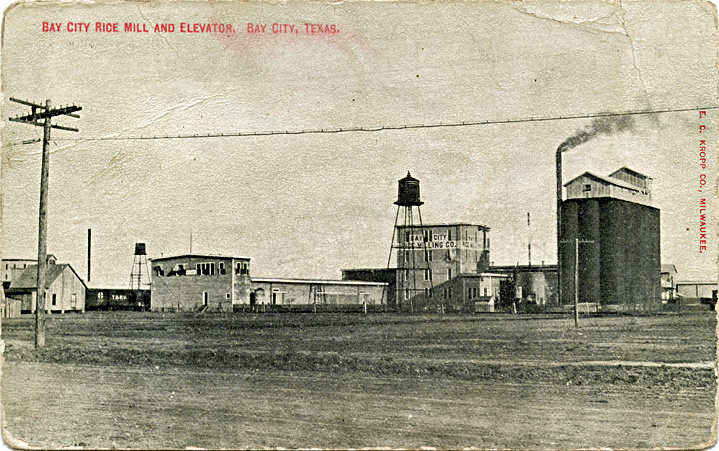 Bay City Rice Mill and Elevator, Bay City, Texas |
|||||
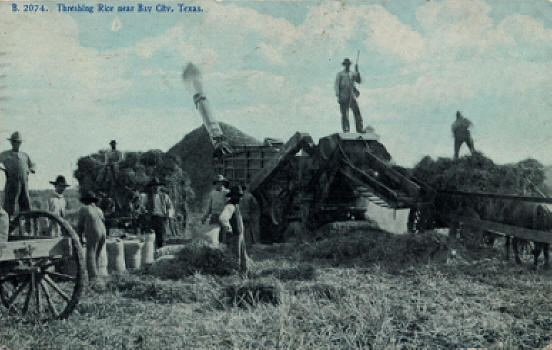 Threshing Rice Near Bay City, Texas |
|||||
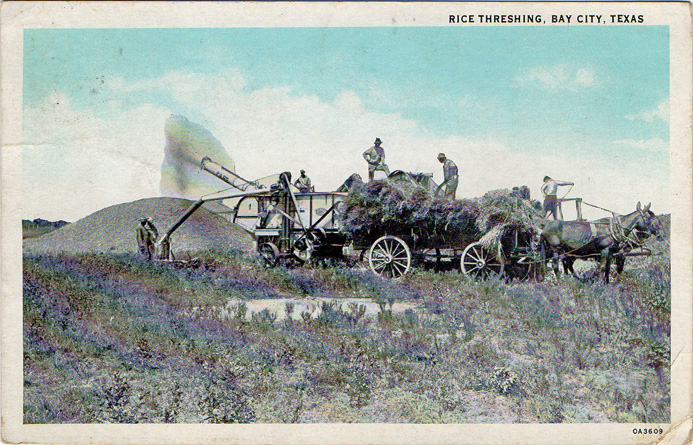 Rice Threshing, Bay City, Texas |
|||||
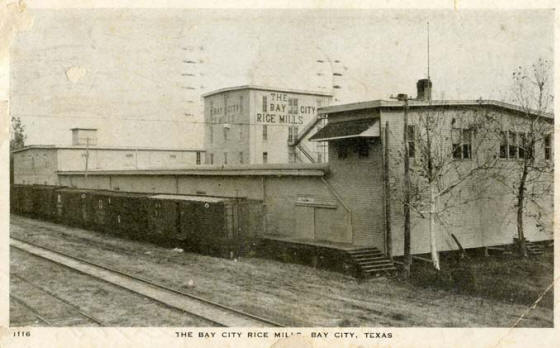 Bay City Rice Mill - Bay City, Texas |
|||||
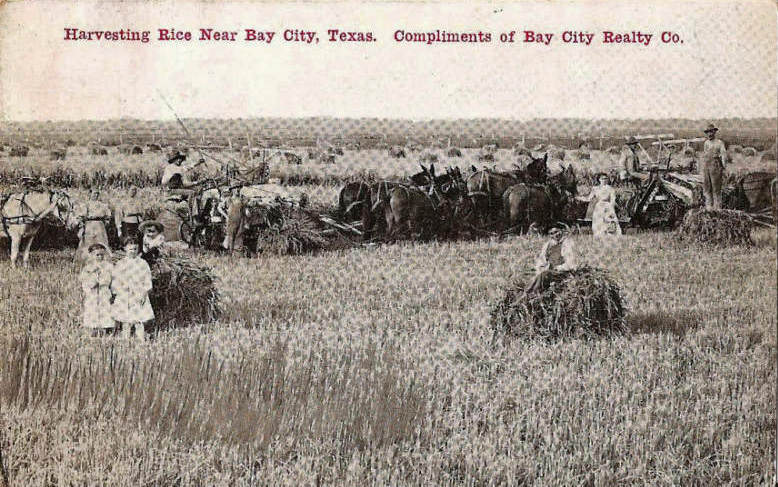 Harvesting Rice Near Bay City, Texas - Compliments of Bay City Realty Co. |
|||||
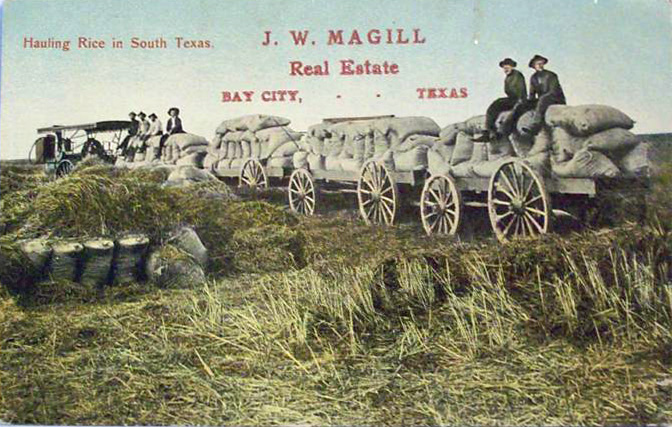 Hauling Rice in South Texas - J. W. Magill Real Estate - Bay City, Texas |
|||||
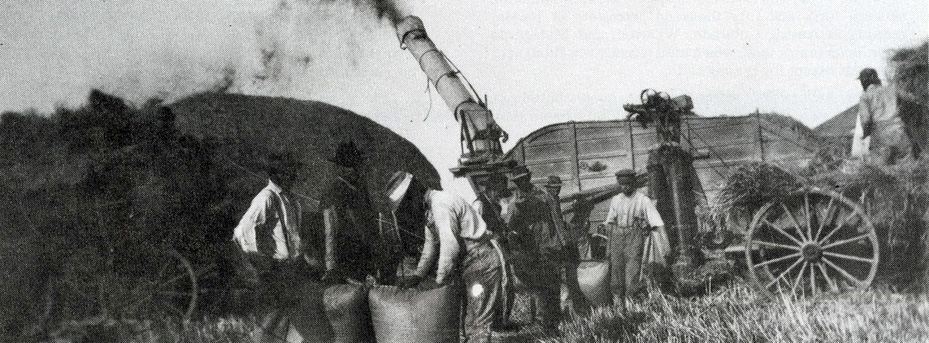 Threshing Rice |
|||||
 Hauling Rice to Warehouse in Bay City - circa 1905 |
|||||
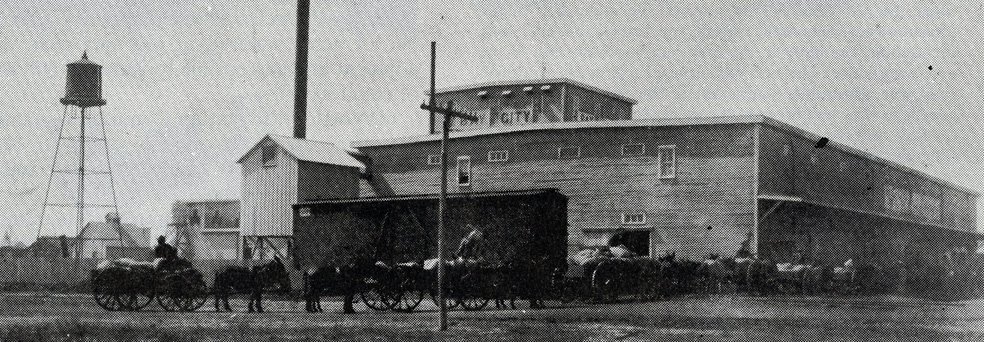 Bay City Rice Warehouse, 1902 |
|||||
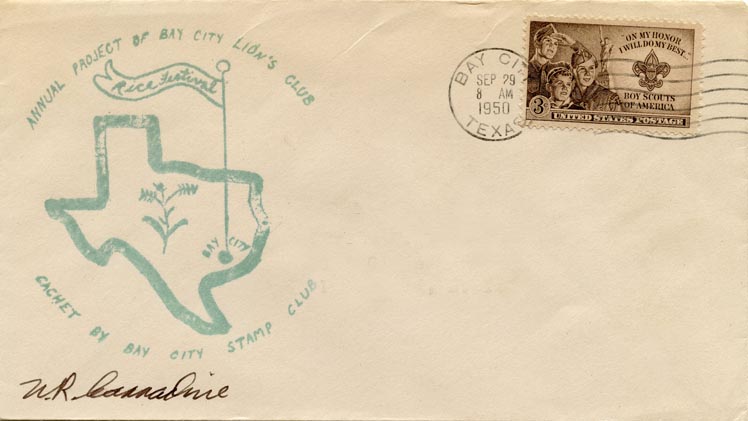 Annual Project of Bay City Lion's Club Rice Festival - Cachet By Bay City Stamp Club - W. R. Carradine |
|||||
|
|||||
|
